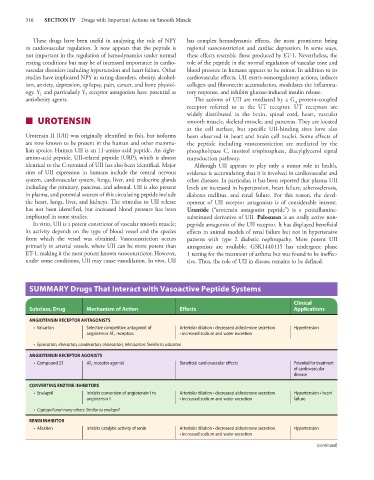Page 330 - Basic _ Clinical Pharmacology ( PDFDrive )
P. 330
316 SECTION IV Drugs with Important Actions on Smooth Muscle
These drugs have been useful in analyzing the role of NPY has complex hemodynamic effects, the most prominent being
in cardiovascular regulation. It now appears that the peptide is regional vasoconstriction and cardiac depression. In some ways,
not important in the regulation of hemodynamics under normal these effects resemble those produced by ET-1. Nevertheless, the
resting conditions but may be of increased importance in cardio- role of the peptide in the normal regulation of vascular tone and
vascular disorders including hypertension and heart failure. Other blood pressure in humans appears to be minor. In addition to its
studies have implicated NPY in eating disorders, obesity, alcohol- cardiovascular effects, UII exerts osmoregulatory actions, induces
ism, anxiety, depression, epilepsy, pain, cancer, and bone physiol- collagen and fibronectin accumulation, modulates the inflamma-
ogy. Y and particularly Y receptor antagonists have potential as tory response, and inhibits glucose-induced insulin release.
5
1
antiobesity agents. The actions of UII are mediated by a G protein-coupled
q
receptor referred to as the UT receptor. UT receptors are
widely distributed in the brain, spinal cord, heart, vascular
■ UROTENSIN smooth muscle, skeletal muscle, and pancreas. They are located
at the cell surface, but specific UII-binding sites have also
Urotensin II (UII) was originally identified in fish, but isoforms been observed in heart and brain cell nuclei. Some effects of
are now known to be present in the human and other mamma- the peptide including vasoconstriction are mediated by the
lian species. Human UII is an 11-amino-acid peptide. An eight- phospholipase C, inositol trisphosphate, diacylglycerol signal
amino-acid peptide, UII-related peptide (URP), which is almost transduction pathway.
identical to the C-terminal of UII has also been identified. Major Although UII appears to play only a minor role in health,
sites of UII expression in humans include the central nervous evidence is accumulating that it is involved in cardiovascular and
system, cardiovascular system, lungs, liver, and endocrine glands other diseases. In particular, it has been reported that plasma UII
including the pituitary, pancreas, and adrenal. UII is also present levels are increased in hypertension, heart failure, atherosclerosis,
in plasma, and potential sources of this circulating peptide include diabetes mellitus, and renal failure. For this reason, the devel-
the heart, lungs, liver, and kidneys. The stimulus to UII release opment of UII receptor antagonists is of considerable interest.
has not been identified, but increased blood pressure has been Urantide (“urotensin antagonist peptide”) is a penicillamine-
implicated in some studies. substituted derivative of UII. Palosuran is an orally active non-
In vitro, UII is a potent constrictor of vascular smooth muscle; peptide antagonist of the UII receptor. It has displayed beneficial
its activity depends on the type of blood vessel and the species effects in animal models of renal failure but not in hypertensive
from which the vessel was obtained. Vasoconstriction occurs patients with type 2 diabetic nephropathy. More potent UII
primarily in arterial vessels, where UII can be more potent than antagonists are available. GSK1440115 has undergone phase
ET-1, making it the most potent known vasoconstrictor. However, 1 testing for the treatment of asthma but was found to be ineffec-
under some conditions, UII may cause vasodilation. In vivo, UII tive. Thus, the role of UII in disease remains to be defined.
SUMMARY Drugs That Interact with Vasoactive Peptide Systems
Clinical
Subclass, Drug Mechanism of Action Effects Applications
ANGIOTENSIN RECEPTOR ANTAGONISTS
• Valsartan Selective competitive antagonist of Arteriolar dilation • decreased aldosterone secretion Hypertension
angiotensin AT 1 receptors • increased sodium and water excretion
• Eprosartan, irbesartan, candesartan, olmesartan, telmisartan: Similar to valsartan
ANGIOTENSIN RECEPTOR AGONISTS
• Compound 21 AT 2 receptor agonist Beneficial cardiovascular effects Potential for treatment
of cardiovascular
disease
CONVERTING ENZYME INHIBITORS
• Enalapril Inhibits conversion of angiotensin I to Arteriolar dilation • decreased aldosterone secretion Hypertension • heart
angiotensin II • increased sodium and water excretion failure
• Captopril and many others: Similar to enalapril
RENIN INHIBITOR
• Aliskiren Inhibits catalytic activity of renin Arteriolar dilation • decreased aldosterone secretion Hypertension
• increased sodium and water excretion
(continued)

